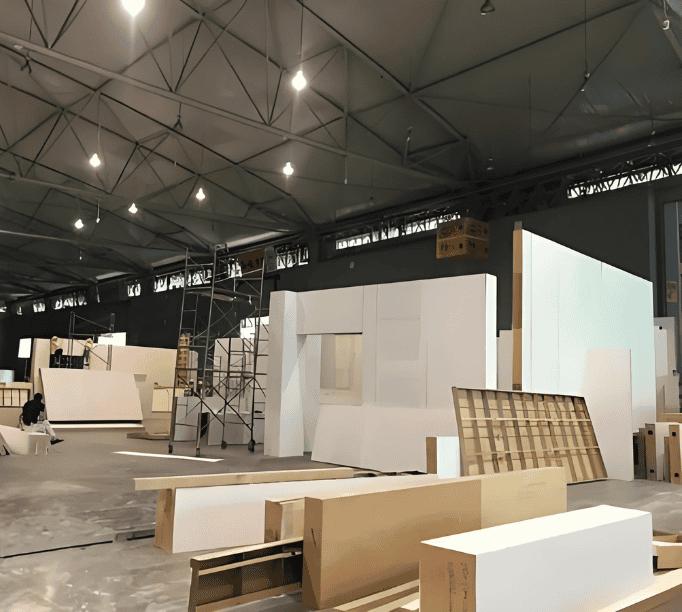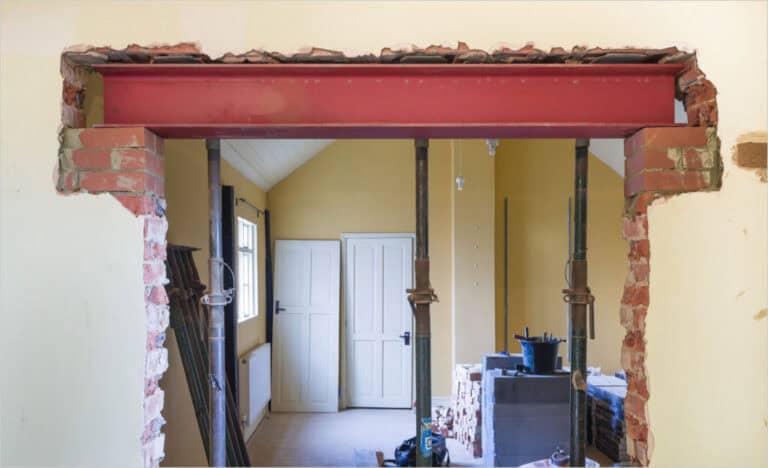Denken Sie für Ihr nächstes Projekt in Südafrika über Fertighäuser nach? Sie fragen sich wahrscheinlich, ob diese wirklich kostengünstiger sind als herkömmliche Bauweisen. Von den Baukosten bis zur langfristigen Instandhaltung hängt die Antwort von mehreren Schlüsselfaktoren ab.
In diesem Leitfaden schlüsseln wir die Kosten für Fertigbau und traditionelle Bauweise auf. Wir vergleichen die Kosten für Fertigbau und traditionelle Bauweise, untersuchen die wichtigsten Kostentreiber in Südafrika und zeigen, wie sich regionale Unterschiede auf Ihr Budget auswirken. Anhand von Fallstudien aus der Praxis erfahren Sie, wie Unternehmen mit SteelPRO Peb-Lösungen Zeit und Geld sparen.
Am Ende wissen Sie genau, wie Sie mit Fertigbauweisen intelligenter planen und Ihr Geld besser ausgeben können.
Vergleichende Kostenanalyse: Fertigbau vs. traditionelle Bauweise
Bei der Bewertung von Baulösungen in Südafrika sind die Kosten nach wie vor einer der entscheidendsten Faktoren für Immobilienentwickler, Unternehmen und Regierungsprojekte. In diesem Abschnitt werden die finanziellen Aspekte von Fertighäusern und traditionellen Bauweisen verglichen, nicht nur hinsichtlich der Anfangsinvestition, sondern über den gesamten Lebenszyklus des Gebäudes.
Niedrigere Anschaffungskosten pro Quadratmeter
Einer der unmittelbarsten Vorteile von Fertighäusern sind die geringeren Anschaffungskosten. Im Durchschnitt sind Fertighäuser pro Quadratmeter deutlich günstiger als herkömmliche Mauerwerks- oder Betonkonstruktionen. Diese Kosteneffizienz ist vor allem auf die Massenproduktion, die bessere Materialausnutzung und den reduzierten Arbeitsaufwand in kontrollierten Fabrikumgebungen zurückzuführen. Für kostensensible Branchen wie Bergbau, Bildung und kleine Unternehmen bedeutet dies mehr Bauvolumen bei geringerem Budget.
Reduzierte Gesamtbetriebskosten
Über die anfängliche Investition hinaus bieten Fertighäuser niedrigere Gesamtbetriebskosten (TCO). Dank moderner, korrosions-, schimmel- und witterungsbeständiger Materialien sind die Wartungskosten tendenziell niedriger. Darüber hinaus sind Fertighäuser aufgrund strengerer Qualitätskontrollen bei Isolierung und Abdichtung im Werk grundsätzlich energieeffizienter. Die langfristigen Einsparungen bei Reparatur- und Betriebskosten tragen erheblich zur Senkung der TCO bei.
Schnellere Kapitalrendite
Zeit ist Geld, insbesondere in Branchen wie Einzelhandel, Gesundheitswesen und Logistik. Die kürzere Bauzeit von Fertighäusern ermöglicht es, Anlagen Wochen oder sogar Monate früher betriebsbereit zu machen als herkömmliche Gebäude. Dieser frühere Baubeginn bedeutet schnellere Umsatzgenerierung oder früheren Zugang zu Einrichtungen. Damit sind Fertighäuser eine wertvolle Option für Investoren, die eine schnellere Abwicklung und einen höheren ROI anstreben.
Bessere Budgettransparenz und Kostenkontrolle
Im Gegensatz zum traditionellen Bauen, bei dem es aufgrund von Wetter, Arbeitskräftemangel oder unerwarteten Baustellenbedingungen häufig zu Kostenüberschreitungen kommt, profitieren Fertigbauprojekte von einer höheren Planbarkeit. Da ein Großteil des Bauprozesses außerhalb der Baustelle mit standardisierten Komponenten und festen Zeitplänen erfolgt, können Kunden ihr Budget genauer planen. Diese Transparenz macht Fertigbauweise besonders für Kunden mit knappen finanziellen Spielräumen oder großen Projekten attraktiv.
Zusammenfassend lässt sich sagen, dass die finanziellen Vorteile von Fertighäusern weit über die anfänglichen Einsparungen hinausgehen. Sie bieten eine überzeugende Kosten-Nutzen-Lösung durch geringere Lebenszykluskosten, kürzere Bauzeiten und eine zuverlässige Budgetplanung.
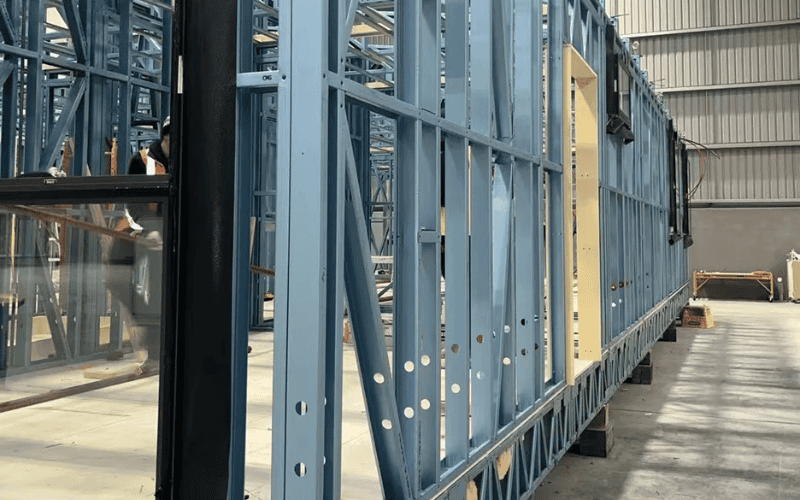
Hauptkostentreiber für Fertighäuser in Südafrika
Wenn Sie ein Fertigbauprojekt in Südafrika planen, können Sie durch das Verständnis der wichtigsten Kostentreiber bessere Planungs- und Beschaffungsentscheidungen treffen. Sehen wir uns die wichtigsten Faktoren an, die die Gesamtinvestition maßgeblich beeinflussen.
1. Materialkosten und lokale Beschaffung
Der Preis wichtiger Baumaterialien wie Stahl und Dämmplatten beeinflusst die Kosten von Fertighäusern maßgeblich. Südafrikas Abhängigkeit von den globalen Stahlpreisen führt dazu, dass Schwankungen auf den internationalen Märkten die Projektbudgets direkt erhöhen oder senken können. Die lokale Materialbeschaffung kann jedoch dazu beitragen, die Kosten zu optimieren, Lieferzeiten zu verkürzen und Einfuhrzölle zu senken. Die Nähe zu zuverlässigen Lieferanten hochwertiger Dämmplatten, Verkleidungen und Rahmenelemente führt oft zu einer besseren Projektkostenkontrolle.
2. Logistik und Transport
Fertigteile werden außerhalb der Baustelle hergestellt und anschließend vor Ort montiert. Für Kunden in abgelegenen Regionen wird der Transport zu einem erheblichen Kostenfaktor. Lange Entfernungen, schlechte Straßenverhältnisse und die Notwendigkeit einer Sonderbehandlung oder der Begleitung übergroßer Ladungen können die Frachtkosten erheblich erhöhen. Daher kann die Zusammenarbeit mit Lieferanten wie SteelPRO Peb, die optimierte Versandrouten und eine Planung der Lieferung vor Ort anbieten, einen echten finanziellen Unterschied machen.
3. Standardisierung vs. Anpassung
Einer der größten Vorteile des Fertigbaus ist die Verwendung standardisierter Module, die Arbeits- und Ausrüstungskosten sparen. Die Serienfertigung von Komponenten sorgt für Effizienz und Preisstabilität. Erfordert ein Gebäude jedoch erhebliche Anpassungen hinsichtlich Abmessungen, Oberflächen oder integrierter Systeme, steigen die Stückkosten. Wenn sich die Projektplanung an Standardvorlagen orientiert, bleiben die Budgets planbarer.
4. Standortvorbereitung und unterstützende Infrastruktur
Oft übersehen, können Fundamentarbeiten und Standortvorbereitungen einen großen Teil des Budgets verschlingen. Unebenes Gelände kann eine Nivellierung, Entwässerungsplanung oder sogar Stützmauern erfordern. Darüber hinaus sind Anschlüsse für Strom, Wasser und Internet unerlässlich, deren Verfügbarkeit – oder deren Fehlen – die Kosten beeinflusst. In manchen ländlichen Gegenden müssen netzunabhängige Lösungen sogar frühzeitig in die Kostenplanung einbezogen werden.
KURZFASSUNG: Jede dieser Komponenten – Materialpreise, Logistik, Gebäudeplanung und Standortbedingungen – beeinflusst Ihre endgültigen Kosten pro Quadratmeter. SteelPRO Peb unterstützt seine Kunden vom ersten Tag an bei der Analyse der Kostentreiber, damit sie fundierte Entscheidungen treffen können, insbesondere bei festen Budgets oder Zeitvorgaben.
Regionale Überlegungen beeinflussen die Kosten in Südafrika
Bei der Planung eines Fertigbauprojekts in Südafrika können regionale Unterschiede Ihre Gesamtkosten erheblich beeinflussen. Kenntnisse der lokalen Gegebenheiten – sowohl wirtschaftlich als auch administrativ – sind unerlässlich, insbesondere wenn Sie neu auf dem südafrikanischen Markt sind.
Beginnen wir mit den Bau-Hotspots. Gauteng, Westkap und KwaZulu-Natal gehören zu den aktivsten Regionen des Landes für Gewerbe- und Wohnbau. Doch jede Region hat ihr eigenes Preisprofil:
- Gauteng: Als Wirtschaftszentrum sind die Grundstückspreise und Arbeitskosten besonders hoch, insbesondere in Johannesburg und Pretoria. Die Projektinfrastruktur ist jedoch im Allgemeinen gut ausgebaut, was dazu beitragen kann, Verzögerungen zu reduzieren.
- Westkap: Westkap ist für seine stabile Verwaltung und effizienten kommunalen Prozesse bekannt und bietet ein zuverlässiges Genehmigungsverfahren. Dennoch gehören die Grundstückspreise rund um Kapstadt zu den höchsten des Landes.
- KwaZulu-Natal: Im Vergleich zu den anderen beiden Provinzen können die Grundstückskosten günstiger sein, insbesondere außerhalb von Durban. Die Arbeitskosten variieren jedoch stark, und die Infrastruktur außerhalb der städtischen Zentren kann logistische Herausforderungen mit sich bringen.
Nun zum Thema Bürokratie: Provinzgesetze und kommunale Genehmigungsfristen sind wichtiger, als viele Erstanwender erwarten. In manchen Provinzen können bürokratische Verzögerungen oder komplexe Vorschriften Ihren Zeitplan um Wochen – manchmal Monate – verlängern, was wiederum die Kosten durch längere Gerätemieten, Arbeitsstunden und Finanzierungskosten in die Höhe treibt.
Eine weitere oft übersehene Variable ist die Verfügbarkeit der Infrastruktur. Gebiete mit schlechtem Stromnetz, eingeschränktem Straßenzugang oder unzureichender Wasserversorgung erfordern zusätzliche Investitionen in temporäre Einrichtungen oder netzunabhängige Lösungen. Dies wirkt sich nicht nur auf die Kosten aus, sondern beeinträchtigt oft auch die Terminplanung und die Einhaltung von Fristen.
Deshalb unterstützen wir bei SteelPRO Peb unsere internationalen Kunden bei der Regionalplanung und Standortwahl. Unsere Experten vor Ort helfen Ihnen, alle standortbezogenen Faktoren abzuwägen, damit Sie nicht von unerwarteten regionalen Unterschieden überrascht werden. Die Wahl der richtigen Region, die Ihren Prioritäten entspricht – ob niedrigere Kosten, schnellere Genehmigungen oder besserer Zugang zur Infrastruktur – kann den Erfolg Ihrer Investition erheblich beeinflussen.
Fallstudien: Kosteneffiziente Fertighausprojekte in Südafrika
Um die Kostenvorteile von Fertighäusern in Südafrika wirklich zu verstehen, ist ein Blick auf reale Anwendungen hilfreich. Bei SteelPRO Peb haben wir mehrere Projekte abgeschlossen, die deutlich zeigen, wie modulare Bauweise Kosten senken und Zeitpläne verkürzen kann, ohne die Qualität zu beeinträchtigen.
Ein herausragendes Projekt ist die Realisierung eines modularen Klassenzimmers für eine Grundschule in Kapstadt. Der Kunde benötigte aufgrund steigender Schülerzahlen und begrenzter Platzverhältnisse eine schnelle Lösung. Durch den Einsatz unserer modularen Bautechniken konnten wir die Bauzeit im Vergleich zu herkömmlichen Methoden um 601 TP3T verkürzen. Noch wichtiger ist, dass die Gesamtprojektkosten um etwa 301 TP3T gesenkt wurden. Die Einsparungen resultierten aus rationalisierten Baustellenarbeiten, werksgesteuerter Produktion und schnellerer Inbetriebnahme – wodurch Ineffizienzen bei Arbeits- und Materialeinsatz minimiert wurden.
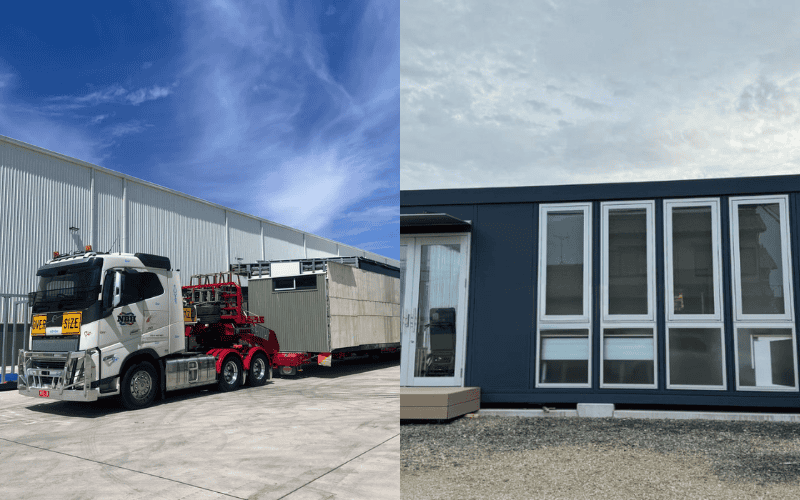
Ein weiteres überzeugendes Beispiel ist ein Gewerbeparkprojekt in Johannesburg. Der Kunde legte Wert auf schnelle Markteinführung und Budgetkontrolle. Wir nutzten ein sich wiederholendes modulares Design, das eine effiziente Herstellung und Wiederverwendung von Komponenten ermöglichte. Diese modulare Wiederholung sparte erheblich Bauzeit und reduzierte das Gesamtbudget deutlich. Der Kunde konnte den Betrieb Wochen früher als ursprünglich geplant aufnehmen und so früher als erwartet Einnahmequellen erschließen.
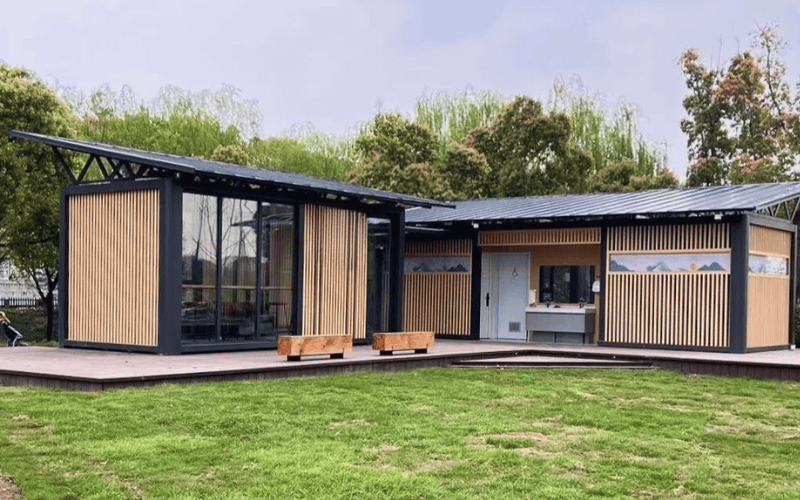
Bei unseren Projekten betonen Kunden oft die verbesserte Transparenz und Kommunikation, die modulares Bauen ermöglicht. Klare Produktionspläne, vorhersehbare Preise und minimale Störungen vor Ort stellen eine deutliche Verbesserung gegenüber herkömmlichen Bauprozessen dar. Ein Projektmanager drückte es so aus: „Bei der Zusammenarbeit mit SteelPRO Peb ging es nicht nur darum, Geld zu sparen – es ging darum, während des gesamten Baus Klarheit und Vertrauen zu gewinnen.“
Diese Fallstudien zeigen, dass Fertigbau nicht nur eine kosteneffiziente, sondern auch eine strategische Entscheidung ist, die betriebliche und qualitative Vorteile bietet. Ob für Schulen, Gewerbebauten oder temporäre Einrichtungen – modulare Lösungen bewähren sich auf dem südafrikanischen Markt weiterhin.
Bei SteelPRO Peb sind wir mehr als nur ein Fertigteillieferant – wir sind Ihr kosteneffizienter Partner in Südafrika.
Egal, ob Sie eine Schule, eine Fabrik oder Gewerbefläche planen, wir helfen Ihnen, die Kosten zu kontrollieren, die Lieferung zu beschleunigen und Risiken zu reduzieren.
Kontaktieren Sie uns noch heute, um herauszufinden, wie wir Ihr nächstes Projekt unterstützen können.
